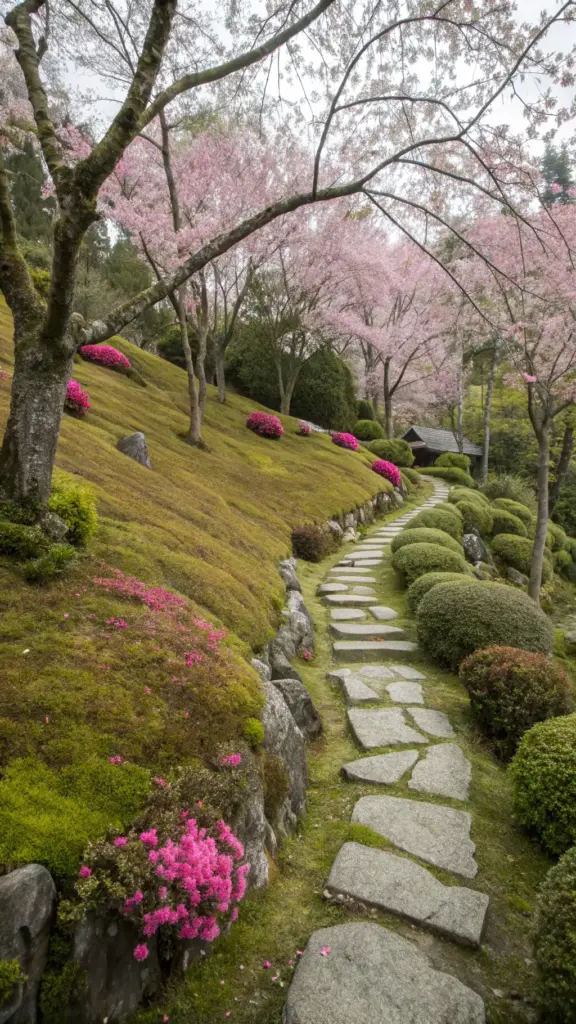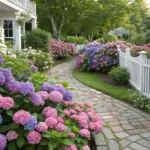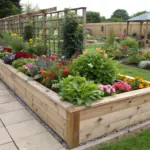8. Japanese Zen-Inspired Hill Garden: Creating Tranquility on a Slope

There’s something almost meditative about a Japanese Zen-inspired garden. The simplicity, the balance, the way every element feels intentional—it’s like stepping into a different world. I’ll never forget the first time I tried to recreate this serene vibe on my own hillside. At first, it felt overwhelming—how do you make a slope feel calm and harmonious? But once I started integrating cherry blossoms, azaleas, and moss, everything clicked. Let me share how you can transform your hill into a peaceful retreat that radiates balance and harmony.
Integrating Cherry Blossoms, Azaleas, and Moss
The cornerstone of any Zen garden is its plant selection, and these three are absolute stars. Cherry blossoms bring a sense of fleeting beauty, their delicate pink blooms reminding us to appreciate the moment.
I planted a row of dwarf cherry trees along the top edge of my hill, and during spring, they create this ethereal canopy that feels straight out of Kyoto. Beneath them, I added clusters of azaleas in soft whites and pinks—they’re low-maintenance and bloom just as the cherry blossoms fade, keeping the color show going.
And then there’s moss—the unsung hero of Zen gardens. It’s not just for looks; moss helps retain moisture and prevents erosion on slopes. I was skeptical at first because moss can be finicky, but once I found the right shady spots and kept the soil consistently damp, it thrived. The result? A lush, velvety carpet that ties everything together.
Pro tip: If moss isn’t thriving in your area, try Irish moss or creeping thyme as alternatives. They mimic the look and feel without being as temperamental.
Using Stepping Stones and Gravel Paths for Accessibility
Paths are more than just functional—they’re an essential part of the Zen aesthetic. Stepping stones and gravel paths guide you through the garden while maintaining that minimalist vibe.
When I designed my hillside path, I used flat, irregular stones spaced just far enough apart for comfortable steps. Between the stones, I filled the gaps with fine gravel, which adds texture and makes the space feel grounded. For narrow hills, winding paths work beautifully—they slow you down and encourage mindfulness as you move through the space.
Here’s a trick I learned: place the stones slightly unevenly. It sounds counterintuitive, but perfectly aligned stones can feel too rigid. A little asymmetry adds authenticity and charm.
Incorporating Water Features Like Mini Ponds or Bamboo Fountains
No Zen garden is complete without water. The sound of trickling water is incredibly soothing, and even small features can make a big impact.
I installed a tiny bamboo fountain near my seating area—it’s simple, elegant, and doesn’t require much maintenance. For those with more space, a mini pond surrounded by smooth river rocks creates a focal point that draws the eye and invites reflection.
One thing to keep in mind: water features need shade to prevent algae growth. I surrounded mine with azaleas and ferns, which not only provide cover but also enhance the tranquil atmosphere. And if you’re worried about mosquitoes, add a small pump to keep the water moving—it’s a lifesaver.
Achieving Balance and Harmony in Your Garden Layout
The heart of a Zen garden is its sense of balance and harmony. This doesn’t mean everything has to be symmetrical—in fact, asymmetry is often more calming.
For example, I grouped plants in odd numbers (like three or five) to create natural-looking clusters. I also left plenty of open space between elements to avoid overcrowding. Too much “stuff” can feel chaotic, and Zen is all about simplicity.
Another key principle is contrast. Pair soft textures like moss with hard surfaces like stone, or bright azalea blooms with the muted tones of gravel. These contrasts highlight each element without competing for attention.
Alright, ready to attract some fluttering friends to your garden? Click the next button below to learn how to create a butterfly-friendly bloomscape that not only supports pollinators but also adds whimsy and movement to your hillside. Spoiler: it’s easier than you think, and the sight of butterflies dancing among your flowers is pure magic!









GIPHY App Key not set. Please check settings